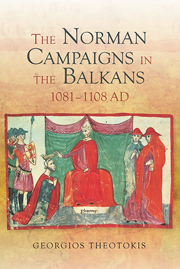Book contents
- Frontmatter
- Contents
- Acknowledgements
- List of abbreviations
- Map I Southern Italy and Sicily
- Map II The island of Sicily
- Map III The southern Balkan peninsula
- Genealogical table: The Norman dukes
- Dedications
- Introduction
- 1 Primary Sources and the Problems of Military History
- 2 Norman Military Institutions in Southern Italy in the Eleventh Century
- 3 The Byzantine Army of the Tenth and Eleventh Centuries
- 4 The Byzantine Naval Forces of the Tenth and Eleventh Centuries
- 5 The Establishment of the Normans in Southern Italy and Sicily
- 6 Robert Guiscard's Invasion of Illyria
- 7 The Norman Advances in the Balkans and the End of the Dream
- 8 Bohemond of Taranto and the First Crusade
- 9 The Count's Campaign of 1107 and the Treaty of Devol
- Conclusions
- List of Byzantine Emperors
- The Hauteville family
- Glossary
- Bibliography
- Index
8 - Bohemond of Taranto and the First Crusade
Published online by Cambridge University Press: 05 October 2014
- Frontmatter
- Contents
- Acknowledgements
- List of abbreviations
- Map I Southern Italy and Sicily
- Map II The island of Sicily
- Map III The southern Balkan peninsula
- Genealogical table: The Norman dukes
- Dedications
- Introduction
- 1 Primary Sources and the Problems of Military History
- 2 Norman Military Institutions in Southern Italy in the Eleventh Century
- 3 The Byzantine Army of the Tenth and Eleventh Centuries
- 4 The Byzantine Naval Forces of the Tenth and Eleventh Centuries
- 5 The Establishment of the Normans in Southern Italy and Sicily
- 6 Robert Guiscard's Invasion of Illyria
- 7 The Norman Advances in the Balkans and the End of the Dream
- 8 Bohemond of Taranto and the First Crusade
- 9 The Count's Campaign of 1107 and the Treaty of Devol
- Conclusions
- List of Byzantine Emperors
- The Hauteville family
- Glossary
- Bibliography
- Index
Summary
For in that same year, on the instructions of Pope Urban, an expedition to Jerusalem was recruited on a massive scale from every land. Bohemond had previously, along with his father Guiscard, invaded Romania [Byzantium], and had always wanted to conquer it for himself. Seeing a great multitude of people travelling through Apulia but lacking a leader, he hastened there, and wishing to be the army's leader and to make them his followers, he placed the badge of this expedition, namely the cross, on his garments.
The preaching of the First Crusade certainly presented Bohemond with a unique opportunity to escape the relentless pressure put on him by his half-brother Roger, who was acting in his own interests as the legitimate heir of Robert Guiscard and had the protection of his uncle Roger of Sicily, who intervened several times in favour of his namesake nephew. Ever since the death of their father in Cephalonia in 1085, the two half-brothers had been locked in an almost continuous civil strife for five years, which saw the emergence of Bohemond as a significant landowner in Apulia and Calabria.
Whether or not Bohemond had possessions of his own before 1085 from which he could draw troops is impossible to say. A rebellion, however, mounted against Roger immediately after receiving news of his father's death, with the aid of Jordan of Capua and other magnates, was a complete success for Bohemond; Roger had to cede to him the important cities of Oria, Taranto, Otranto, Gallipoli and the lands of his cousin Geoffrey of Conversano, which included Conversano, Montepeloso, Polignano, Monopoli and Brindisi.
- Type
- Chapter
- Information
- The Norman Campaigns in the Balkans, 1081-1108 AD , pp. 185 - 199Publisher: Boydell & BrewerPrint publication year: 2014



